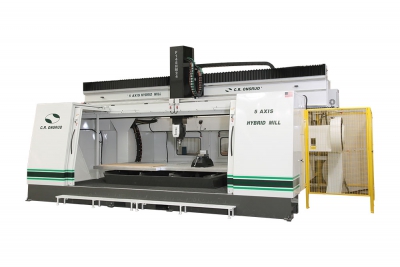
C.R.Onsrud introduces a hybrid of traditional milling technology with the productivity of high-speed machining. This American-made 5-axis machining center is configured with dual tables eliminating load unload time. It also has the capability to electronically lock the two tables together for machining of large parts.
The optional Dual Process technology allows independent program machining on each of the two tables simultaneously for maximum flexibility.
The Onsrud Hybrid Mill is offered in two standard configurations: a nominal 8-foot or 12-foot bed width. Available options include dual spindles, high-speed spindles and quick change, large-capacity toolchangers.
“We repeatedly come upon machinists and fabricators requiring a large work volume who would benefit from the high speed machining of a router, that don’t want to incur the expense of a large traditional mill,” says Jeff Onsrud, directory of sales and business development. “Now we just combined them into the Hybrid Mill and you have the best of both worlds.”
C.R.Onsrud Hybrid Mill, “HM Series,” features 15 HP, 24,000 RPM spindles (with 24 HP and 33 HP options); Control FANUC 31i or Osai Open; Tool Management is a 24 position quick-change (with 100+ position changer options); Material Clamping is by Vacuum Hold Down (with optional Fixture Plate or T-Slot tables; Chip Handling by Chip Pan (with optional Chip Conveyor); Other Hybrid Mill options are Inkjet Part Marking, Auto Tool Measurement, Robotics Integration, Continuous C-Axis, and Linear Scale Feedback.
C.R.Onsrud F98HM specifications are X travel of 60 inches, Y travel of 98 inches, Z travel of 41 inches; overall length of 184 inches, overall width of 320 inches, overall height of 169 inches.
Model F148HM specifications are X travel of 60/72 inches, Y travel of 144 inches, and Z travel
of 169 inches, with overall length of 184 inches, overall width of 144 inches, and overall height of 169 inches.
Contact Details
Related Glossary Terms
- fixture
fixture
Device, often made in-house, that holds a specific workpiece. See jig; modular fixturing.
- gang cutting ( milling)
gang cutting ( milling)
Machining with several cutters mounted on a single arbor, generally for simultaneous cutting.
- machining center
machining center
CNC machine tool capable of drilling, reaming, tapping, milling and boring. Normally comes with an automatic toolchanger. See automatic toolchanger.
- milling
milling
Machining operation in which metal or other material is removed by applying power to a rotating cutter. In vertical milling, the cutting tool is mounted vertically on the spindle. In horizontal milling, the cutting tool is mounted horizontally, either directly on the spindle or on an arbor. Horizontal milling is further broken down into conventional milling, where the cutter rotates opposite the direction of feed, or “up” into the workpiece; and climb milling, where the cutter rotates in the direction of feed, or “down” into the workpiece. Milling operations include plane or surface milling, endmilling, facemilling, angle milling, form milling and profiling.
- milling machine ( mill)
milling machine ( mill)
Runs endmills and arbor-mounted milling cutters. Features include a head with a spindle that drives the cutters; a column, knee and table that provide motion in the three Cartesian axes; and a base that supports the components and houses the cutting-fluid pump and reservoir. The work is mounted on the table and fed into the rotating cutter or endmill to accomplish the milling steps; vertical milling machines also feed endmills into the work by means of a spindle-mounted quill. Models range from small manual machines to big bed-type and duplex mills. All take one of three basic forms: vertical, horizontal or convertible horizontal/vertical. Vertical machines may be knee-type (the table is mounted on a knee that can be elevated) or bed-type (the table is securely supported and only moves horizontally). In general, horizontal machines are bigger and more powerful, while vertical machines are lighter but more versatile and easier to set up and operate.
- robotics
robotics
Discipline involving self-actuating and self-operating devices. Robots frequently imitate human capabilities, including the ability to manipulate physical objects while evaluating and reacting appropriately to various stimuli. See industrial robot; robot.






